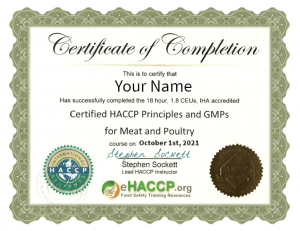
How HACCP can Improve Profibaility for Food Manufacturing Companies
HACCP (Hazard Analysis and Critical Control Points) can improve profitability for a food manufacturing company in several ways.
LUNENBURG, NS, CANADA, July 8, 2024 /EINPresswire.com/ -- HACCP (Hazard Analysis and Critical Control Points) can improve profitability for a food manufacturing company in several ways:Reduced Costs: Implementing HACCP helps identify and mitigate risks related to food safety. By preventing contamination or hazards early in the production process, companies can avoid costly recalls, product wastage, and potential legal fees associated with non-compliance.
Enhanced Efficiency: The systematic approach of HACCP requires companies to analyze their processes thoroughly. This often leads to streamlining operations, optimizing workflows, and reducing unnecessary steps or redundancies, thereby improving overall efficiency.
Improved Product Quality: HACCP emphasizes maintaining consistent product quality and safety standards. By adhering to these rigorous standards, companies can enhance their brand reputation, customer satisfaction, and potentially command premium pricing for their products in the market.
Market Access: Many retailers and distributors require food manufacturers to have HACCP systems in place to ensure food safety and quality. Compliance with HACCP standards can open up new market opportunities and enable companies to enter into contracts with larger retailers or export to international markets where such standards are mandated.
Employee Morale and Training: HACCP implementation involves training employees on food safety practices and their roles in maintaining these standards. Well-trained employees are more likely to adhere to protocols, leading to fewer errors, accidents, and downtime, thereby contributing to overall productivity and profitability.
Customer Confidence: Consumers are becoming increasingly aware of food safety issues. Companies that implement HACCP can reassure customers of their commitment to producing safe and high-quality food products, leading to greater consumer trust and loyalty.
Regulatory Compliance: Compliance with HACCP regulations is often mandatory in many countries. Avoiding fines and penalties associated with non-compliance can directly contribute to profitability by minimizing legal costs and disruptions to operations.
In essence, HACCP not only ensures food safety but also promotes operational efficiency, reduces costs, and enhances market competitiveness, all of which collectively contribute to improving profitability for food manufacturing companies.
HACCP (Hazard Analysis and Critical Control Points) is considered a highly effective food safety system for several reasons:
1. Preventive Approach: Unlike traditional inspection-based methods, HACCP is proactive and preventive. It identifies potential hazards in food production processes and establishes critical control points (CCPs) where these hazards can be controlled or eliminated before they pose a risk to consumers.
2. Systematic and Science-Based: HACCP is a systematic approach based on scientific principles. It involves identifying hazards, assessing their risks, and implementing control measures to prevent, eliminate, or reduce these risks to safe levels. This structured methodology ensures thorough risk assessment and mitigation.
3. Focus on Critical Control Points: HACCP focuses on critical points in the production process where hazards can be effectively controlled. By monitoring and managing these critical control points, food manufacturers can ensure consistent safety and quality of their products.
4. Global Recognition and Acceptance: HACCP is internationally recognized and accepted as a standard for food safety management. Many countries and regulatory agencies require or recommend HACCP implementation for food businesses, making it a globally recognized benchmark for ensuring food safety.
5. Flexibility and Adaptability: HACCP principles can be applied to various sectors of the food industry, including production, processing, packaging, and distribution. It can be tailored to specific processes and hazards relevant to different food products, ensuring flexibility in implementation.
6. Continuous Improvement: HACCP promotes a cycle of continuous improvement through regular monitoring, verification, and review of procedures. This ensures that food safety measures are regularly updated and adjusted based on new information, scientific developments, or changes in production processes.
7. Consumer Confidence and Trust: Implementing HACCP demonstrates a commitment to food safety and quality, which enhances consumer confidence in products. Consumers are increasingly aware and concerned about food safety issues, and HACCP helps food manufacturers meet these expectations.
8. Legal and Regulatory Compliance: Compliance with HACCP principles helps food businesses meet legal requirements and regulatory standards related to food safety. It reduces the risk of non-compliance penalties, product recalls, and legal liabilities associated with foodborne illness outbreaks.
Overall, HACCP's systematic, preventive, and science-based approach makes it an effective food safety system that not only protects consumers but also benefits food businesses by improving operational efficiency, reducing costs, and enhancing market competitiveness.
Contact eHACCP.org to help you select a HACCP course and get your HACCP certificate today.
Stephen Sockett
eHACCP.org
+1 9023437763
email us here
Visit us on social media:
Facebook
X
LinkedIn
YouTube
Other
EIN Presswire does not exercise editorial control over third-party content provided, uploaded, published, or distributed by users of EIN Presswire. We are a distributor, not a publisher, of 3rd party content. Such content may contain the views, opinions, statements, offers, and other material of the respective users, suppliers, participants, or authors.



